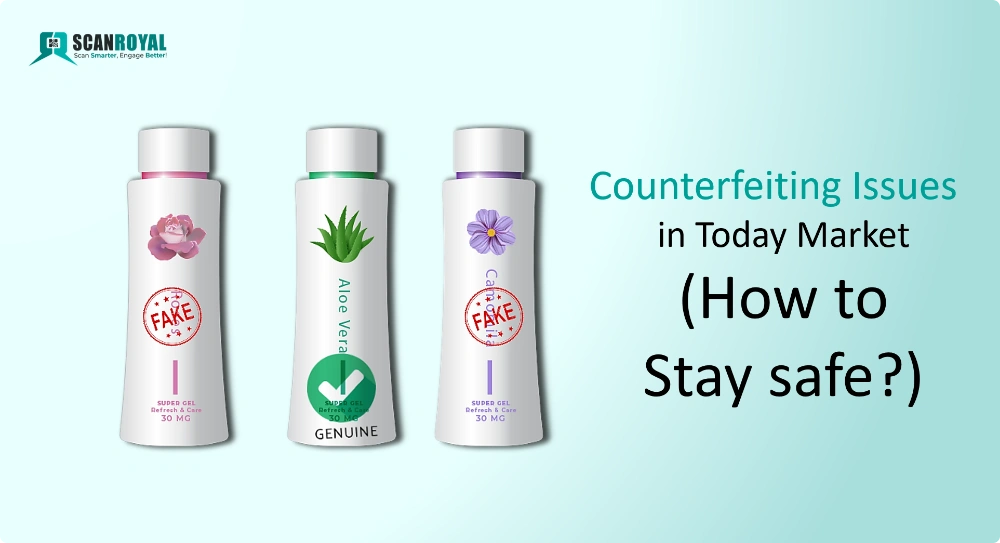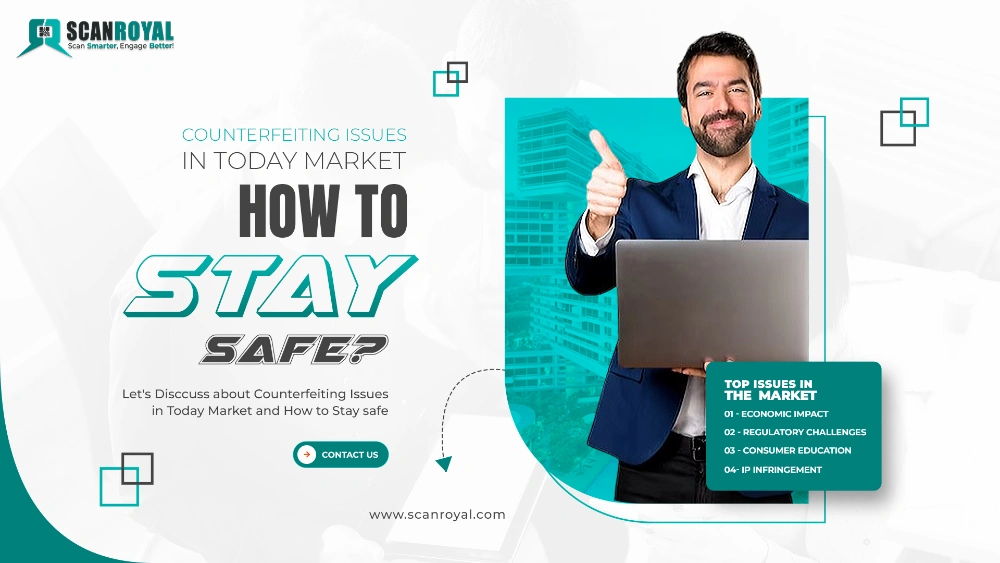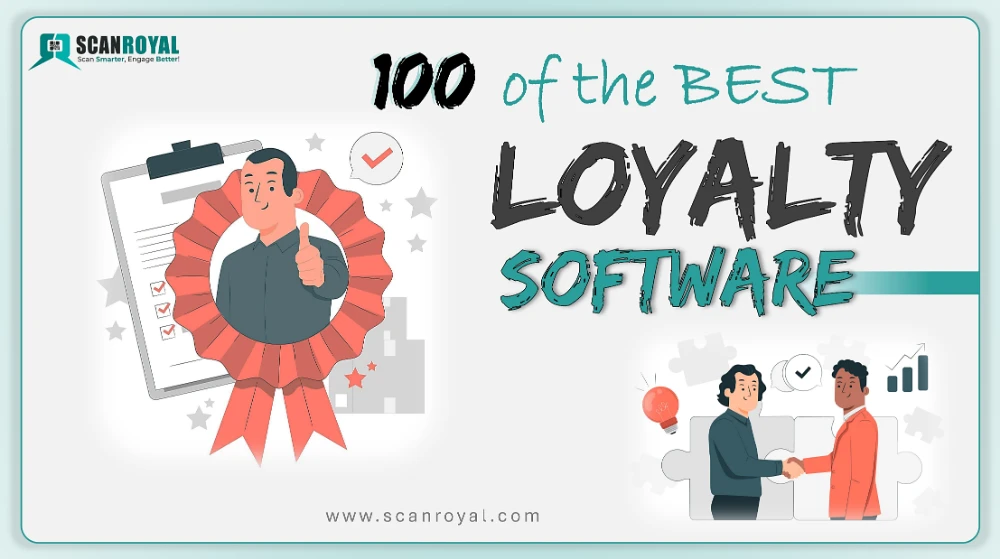In today’s complex market, “counterfeiting products” refers to the unlawful reproduction and distribution of goods, typically sold as authentic from well-known brands.
The alarming rise in counterfeit items across industries threatens consumers, businesses, and the global economy. Lets explore Counterfeiting Issues and learn how to stay safe from it.
From counterfeit drugs harming public health to fake gadgets risking safety, the effects are far-reaching. Countering counterfeiting issues is crucial to addressing these growing concerns. Unpacking the economic, health, and legal repercussions helps us grasp the need of taking strong actions to protect consumers and legitimate businesses from counterfeit items.
What is Counterfeit?
Counterfeit products are made to look like real ones from well-known brands. Counterfeiters make as well as sell products that look popular and trusted brands in order to capitalize on market demand.
These copycat items are often low-quality in materials and craftsmanship, endangering customers and businesses. To capitalize on brand reputations, counterfeiting occurs in fashion, electronics, pharmaceuticals, and other industries.
Counterfeiting issues violates legitimate manufacturers’ trademarks, patents, and copyrights. Key signs are needed to distinguish authentic from counterfeit merchandise. Quality materials, perfect craftsmanship, and original branding are hallmarks of genuine products.
However, counterfeit items may have tiny but important differences like misspelled brand names, logo modifications, or inadequate packaging. Customers can also check stitching patterns, color consistency, and holographic labels for authenticity. Buying from approved sellers in stores or on trusted online platforms ensures product credibility. Technology like smartphone apps and brand-provided internet verification tools helps identify authentic and counterfeit merchandise.
Real-life case studies show how counterfeit items affect individuals, businesses, and industries. Pharmaceutical counterfeits have caused serious health problems for unwitting consumers. The economic impact of counterfeit clothing on brand value and consumer trust has been highlighted by high-profile fashion industry lawsuits. Because counterfeit auto parts compromise vehicle performance, the automobile industry has safety concerns.
These case studies demonstrate the need for strict counterfeiting laws to safeguard consumers and legitimate enterprises. Stakeholders can comprehend the counterfeiting problem and advocate for proactive solutions by seeing real-world repercussions.
-by ScanRoyal
Decoding the Counterfeit Landscape
The pernicious habit of counterfeiting affects everything from common items to luxury goods. From fake drugs endangering patients to fake fashion accessories tarnishing luxury brands, the spectrum is wide.
Counterfeiting issues affects electronics, car parts, even food and drinks. Consumers find it harder to tell fakes from real ones when product duplication becomes more sophisticated.
Fashion, electronics, medicines, and autos are especially vulnerable to counterfeiting. Famous fashion businesses fight counterfeit clothing and accessories that dilute brand value and consumer trust.
Substandard and potentially harmful counterfeit components in the electronics supply chain threaten manufacturers and consumers. Pharmaceutical counterfeits violate intellectual property and endanger public health by exposing unwary consumers to unsafe or hazardous ingredients. Counterfeit auto parts compromise vehicle safety and performance, endangering drivers and passengers. Understanding each industry’s dynamics is essential for establishing focused counterfeiting mitigation methods.
The worldwide economic impact of counterfeit goods goes beyond individual industries. The World Health Organization believes that counterfeit pharmaceuticals bring in billions of dollars worldwide, damaging public health systems and causing massive fiscal costs. By 2022, counterfeiting and piracy might cost $4.2 trillion globally, according to the International Chamber of Commerce. This economic impact includes job losses, diminished innovation incentives, and lower government tax revenues.
Given the global economy’s interconnectedness, counterfeiting issues affects international trade and economic stability far beyond the countries where the unlawful products are manufactured. The pervasiveness of counterfeiting shows that a coordinated effort is needed to reduce economic damage and preserve global markets.
Top 8 Counterfeiting Issues in The Market
Counterfeiting is a significant issue in today’s global market across various industries. Counterfeit goods are imitations of genuine products that are designed to deceive consumers into believing they are purchasing authentic items. This problem affects both consumers and businesses and has widespread economic, social, and health implications.

Here are some key aspects of counterfeiting issues in today’s market:
#1. Economic Impact
Counterfeiting results in significant economic losses for legitimate businesses. Companies lose revenue as counterfeiters profit from selling fake products without investing in research, development, or quality control.
#2. Global Scope
The rise of e-commerce and international trade has facilitated the global spread of counterfeit goods. It can easily cross borders, making it challenging for authorities to regulate and control.
#3. Technology and Sophistication
Advancements in technology have made it easier for counterfeiters to produce high-quality imitations. From fake luxury goods to pharmaceuticals, counterfeiters use sophisticated methods to replicate products, packaging, and even holographic security features.
#4. Health and Safety Concerns
Counterfeit products, especially in industries like pharmaceuticals, automotive parts, and electronics, pose serious health and safety risks. Consumers may unknowingly purchase substandard or dangerous products that can lead to injury or even death.
#5. Intellectual Property (IP) Infringement
Counterfeiting involves the violation of intellectual property rights, including trademarks, patents, and copyrights. This undermines the incentive for innovation and creativity, as companies are less likely to invest in research and development if their products can be easily replicated.
#6. Consumer Trust and Brand Image
Counterfeiting issues damages the trust consumers have in brands. When customers unknowingly purchase fake products, they may experience dissatisfaction and lose confidence in the authenticity of the brand.
#7. Regulatory Challenges
Enforcing anti-counterfeiting measures is challenging due to the complexity of global supply chains and the ability of counterfeiters to adapt to changing regulations. Coordination among countries and regions is essential to combat the issue effectively.
#8. Consumer Education
Lack of awareness among consumers about the prevalence and risks of counterfeit products contributes to the problem. Educating consumers about how to identify authentic products and the dangers associated with counterfeits is crucial.
To address counterfeiting issues, governments, businesses, and international organizations must work collaboratively to strengthen intellectual property protection, improve enforcement mechanisms, and raise awareness among consumers.
Technologies such as blockchain and product serialization are also being explored to enhance supply chain transparency and traceability, making it more difficult for counterfeiters to operate undetected.
Steps to STAY SAFE
Consumers can avoid buying counterfeit goods using these tips.
- Buy from authorized stores and brand websites to ensure authenticity.
- Brand authentication tools and verification apps can be used to verify product information online.
- Items may be counterfeit if they include spelling or grammar mistakes, are of low quality, or have unusual logos or labels.
- Counterfeiters typically offer significantly discounted prices, so be wary of them.
- Check stitching, color uniformity, and holographic labels. These variations are frequently slight yet obvious in counterfeit products.
- Scanning products with smartphone apps with image recognition technology provides fast authenticity feedback. Some apps let you check products against a database of real ones.
- Choose reputable retailers who provide authentic products. Reputable retailers value consumer confidence and don’t sell counterfeit goods.
- If something seems odd or too good to be true, evaluate the purchase. Authentic products usually consistent in quality and price.
The Dangers of Counterfeit Products
Unsuspecting consumers may accidentally ingest poor or hazardous counterfeit items. Pharmaceutical counterfeits can contain incorrect or insufficient active components, causing treatment failures or serious health issues.
Fake cosmetics may include dangerous substances that cause skin responses and long-term health problems. Ingredient safety concerns arise when replicating food and beverages, which could lead to contamination and broad health risks.
The risk of unintentionally buying counterfeit items increases as consumers shop online, underlining the need for public awareness and education to reduce these health concerns.
-by ScanRoyal
Businesses and consumers are affected by counterfeit items’ economic effects across the supply chain. Legitimate businesses suffer income losses, brand damage, and higher anti-counterfeiting expenditures. Counterfeit competition may hurt small firms financially.
However, consumers lose money when they inadvertently buy counterfeit goods at similar costs. Due to counterfeiters’ unfair competition, legitimate businesses may have to shrink or close, resulting in job losses. The intricate economic network linking producers, distributors, retailers, and consumers makes it urgent to address counterfeiting’s economic effects to sustain industries and defend consumer rights.
Buyers and sellers of counterfeit goods face serious legal consequences. Consumers who buy counterfeit items may unwittingly violate intellectual property and trademark laws. Selling counterfeit goods violates intellectual property laws and carries civil and criminal penalties.
Countries have strict counterfeiting laws, and law enforcement actively pursues counterfeiters. Beyond individual transactions, the legal ramifications affect intellectual property enforcement and fair competition.
Consumers must be aware of the legal risks of buying counterfeit items to promote accountability and discourage illegal trading. Understanding the health, economic, and legal aspects of counterfeit products is essential for developing comprehensive solutions.
Identifying Counterfeit Products
Since counterfeiters constantly improve their methods, identifying fakes requires a keen eye. Subpar materials, craftsmanship, and packaging errors like misspelled brand names or logos are hallmarks of counterfeit items. Red flags include color, design, and quality inconsistencies.
Fake products often sell for a fraction of the real price to attract unwary buyers. Understanding these warning indicators helps buyers avoid counterfeit products and make informed purchases. Consumer education on counterfeit detection is crucial. Safeguards include inspecting the packing, looking for holographic labels, and buying from trusted sellers. Official brand websites can help consumers check product authenticity and cross-reference information. Researching products, reading reviews, and avoiding scams contribute to a diligent consumer culture.
We can build a more robust market that fights counterfeit goods by raising knowledge and encouraging people to trust their intuition. Technology has become a strong tool in the fight against counterfeiting issues. Blockchain technology lets consumers track a product’s supply chain, verifying its validity. Mobile apps with image recognition let buyers scan things and get fast authenticity feedback.
Companies are also designing products with RFID tags and tamper-evident packaging. Businesses and consumers may stay ahead of counterfeiters by adopting these technologies, creating a more secure, authentic marketplace. As we negotiate the complex world of counterfeit product identification, consumer education and cutting-edge technology strengthen our defenses.
Product Counterfeiting Issues and Solutions
Combating counterfeiting issues is difficult. Counterfeiters adapt to avoid detection, which is a major challenge. International trade makes it difficult to manage and monitor counterfeit goods networks.
Let’s Understanding Product Counterfeiting Issues
Corruption, insufficient sanctions, and poor legal frameworks in some places perpetuate counterfeiting. Counterfeiters can operate anonymously on online platforms because of their size. Governments, companies, and inventors must collaborate to solve these complex issues.

The counterfeiting problem is serious, and governments and businesses worldwide are taking action. Governments deter counterfeiting by strengthening intellectual property laws, regulatory structures, and penalties. National and international interagency collaborations to share intelligence and fight counterfeiting networks are growing. Promotion of best practices, public awareness initiatives, and law enforcement collaboration are also important for industry associations.
Pharmaceutical companies combine to secure the supply chain and protect customers from counterfeit pharmaceuticals. These projects demonstrate the need for a cross-sectoral approach to combat counterfeiting issues.
How to Stay Safe From It?
Innovative product authentication and traceability solutions help fight counterfeiting with technology. Blockchain’s decentralized and transparent ledger is being used to establish tamper-proof supply networks. Supply chain transparency and counterfeiting prevention depend on serialization and track-and-trace technologies. Serial numbers or barcodes are used to track products from manufacturing to distribution in these systems.
Holograms, RFID tags, and QR codes let consumers and authorities verify product legitimacy. RFID tags allow real-time tracking, QR codes provide product information, and holograms verify authenticity.
These technologies dissuade counterfeiters and help detect and remove bogus products from the market as they improve. In addition, integrating AI and ML approaches changes the counterfeiting fight.
Large serialization and track-and-trace records are evaluated for counterfeit patterns and trends. AI systems can quickly evaluate large amounts of data to identify anomalies or suspicious trends that may indicate counterfeit products.
This proactive approach allows authorities and businesses to act quickly, minimizing counterfeit goods’ impact on consumers and brand reputation. Serialization, track-and-trace systems, and advanced technology provide a powerful barrier against counterfeiting issues in the current market.

A complete counterfeiting strategy extends beyond technology and is multifaceted. A strong legal framework with clear penalties for counterfeiters is needed. Governments, businesses, and international organizations must collaborate to share information, coordinate actions, and apply consistent measures globally. Public knowledge and education about counterfeit product concerns can help customers make informed decisions. Legal measures, collaborative efforts, and cutting-edge technology may develop a resilient counterfeiting defense that targets its fundamental causes and protects the supply chain. This comprehensive approach protects consumers and creates a trustworthy and secure corporate environment.
Importance of Supporting Legitimate Brands and Businesses
Supporting legal brands and businesses is crucial to a sustainable and ethical market. Beyond transactions, it benefits consumers, industry, and the global economy. First and foremost, supporting authorized brands protects quality and safety. Legitimate brands invest in extensive research, development, and quality control to ensure product safety and consumer trust.
By picking these companies, consumers promote safety and excellence in the market. Additionally, supporting legal brands helps foster innovation. Genuine firms drive industry improvements, generate healthy competition, and push the limits. These firms’ sponsorship allows them to invest in R&D, advancing technology and fostering a culture of innovation that benefits society. This drive to innovation enhances product quality as well as sets a standard for other businesses.
Protecting employment and the economy requires supporting legitimate brands. Buyers of lawful products support these firms, preserving jobs and the economy. Legitimate brands boost local and global economies through fair competition. Supporting trusted brands takes ethics. Sustainable companies encourage environmental and CSR. Consumer support of ethical brands makes company more sustainable and socially conscientious. Finally, supporting genuine brands builds trust. A brand’s success depends on consumer trust, and authentic products sustain market integrity. Trust improves brand value, transparency, and responsibility, strengthening the business ecosystem.
Conclusion: Action to Protect Consumers and Legitimate Firms
This market’s extensive counterfeiting requires coordinated action to protect consumers and legitimate firms. We assessed counterfeiting’s health, economic, and legal concerns from common products to the most affected industries. Technology offers creative ways to spot counterfeit products, but a keen eye and awareness of crucial indicators are needed.
Fighting counterfeiting issues involves government-industry cooperation. This complex environment requires consumers to be vigilant and follow counterfeit prevention recommendations, while businesses must take robust anti-counterfeiting measures to protect their products and market integrity. We can prevent counterfeits and safeguard customers by raising awareness, employing technology, and supporting real enterprises.










8 responses to “8 Counterfeiting Issues in Today’s Market – How to STAY Safe”
Thanks for sharing. I read many of your blog posts, cool, your blog is very good.
voluptas velit voluptatibus qui cumque fugit sed eos at doloribus repudiandae dolorum occaecati provident exercitationem sunt mollitia. iusto dolor nisi quasi reiciendis dolore velit explicabo recusandae nulla voluptatem cum fuga quisquam eum accusamus sed autem vero deserunt. omnis non consequatur expedita maiores culpa minima magnam voluptas laboriosam doloribus nisi animi ducimus eaque possimus eligendi voluptates deleniti occaecati nulla.
Can you be more specific about the content of your article? After reading it, I still have some doubts. Hope you can help me.
voluptates ducimus quasi voluptas voluptas eligendi assumenda necessitatibus excepturi ea eligendi. nostrum ut rerum odio animi voluptates non. dolore voluptatem dolorem voluptates veritatis culpa quas quae sit labore sit voluptates omnis.
Can you be more specific about the content of your article? After reading it, I still have some doubts. Hope you can help me.
I am not sure where you’re getting your information, but good topic.
Can you be more specific about the content of your article? After reading it, I still have some doubts. Hope you can help me.
Can you be more specific about the content of your article? After reading it, I still have some doubts. Hope you can help me. https://accounts.binance.com/sl/register?ref=OMM3XK51